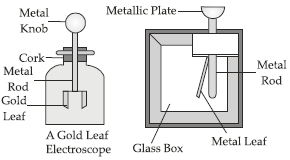Some Natural Phenomena (Physics) Class 8 - NCERT Questions
Which of the following cannot be charged easily by friction?
(A) A plastic scale
(B) A copper rod
(C) A inflated balloon
(D) A woollen cloth.
A copper rod.
Q 2.When a glass rod is rubbed with a piece of silk cloth the rod
(A) and the cloth both acquire positive charge
(B) becomes positively charged while the cloth has a negative charge
(C) and the cloth both acquire negative charge
(D) becomes negatively charged while the cloth has a positive charge.
The cloth becomes positively charged while the cloth has a negative charge.
Q 3.Write ‘T’ against true and ‘F’ against false in the following statements
(A) Like charges attract each other.
(B) A charged glass rod attract a charged plastic straw.
(C) Lightning conductor cannot protect a building from lightning.
(D) Earthquakes can be predicted in advance.
(A) False (b) True (C) False (D) False
Q 4.Sometimes a crackling sound is heard while taking off sweater during winters. Explain.
SOLUTION:The electric discharge takes place between body and sweater. At the time of electric discharge some energy is released. In this case energy is released in the form of cracking sound.
Q 5.Explain why a charged body loses its charge if we touch it with our hand.
SOLUTION:When we touch a charged body, it loses its charge, due to the process of earthing. Our body is a good conductor of electricity. It transfers the charges to the earth.
Q 6.Name the scale on which the destructive energy of an earthquake is measured. An earthquake measures 3 on this scale. Would it be recorded by a seismograph? Is it likely to cause much damage?
SOLUTION:The scale used to measure earthquake is Richter Scale. Reading of this scale is from 1 to 10. The reading of magnitude 3 on the Richter scale would be recorded by a seismograph. The earthquake with magnitude of 3 on Richter Scale is not likely to cause much damage.
Q 7.Suggest three measures to protect ourselves from lightning.
SOLUTION:Three measures of protection are:
(i) Stay under covered area or inside the room.
(ii) We should not use TV or phone during lightning.
(iii) We should not take bath during lightning.
Explain why a charged balloon is repelled by another charged balloon whereas an uncharged balloon is attracted by another charged balloon.
SOLUTION:We know the like charges repel each other. A charged balloon is repelled by another charged balloon because both the balloons contain same type of charges. When a charged balloon is brought near an uncharged balloon, uncharged balloon acquires opposite charge by induction. Since unlike charges attract each other. Therefore charged balloon attracts uncharged balloon.
Q 9.Describe with the help of a diagram an instrument which can be used to detect a charged body.
SOLUTION:An electroscope is used to detect that a body is charged or not. It works on the principle that like charges repel each other.
When the metal strips repel each other, proves that the body is charged because repulsion is the sure test to detect that a body is charged or not.

List three states in India where earthquakes are more likely to strike.
SOLUTION:(i) Kashmir
(ii) Rajasthan
(iii) Gujarat
Suppose you are outside your home and earthquake strikes. What precautions would you take to protect yourself?
SOLUTION:(i) We should move to an open space.
(ii) We should not take shelter under trees or buildings.
(iii) If we are driving, we should slow down the vehicle and move slowly away that area to a clear spot.
The weather department has predicted that a thunderstorm is likely to occur on a certain day. Suppose you have to go out on that day. Would you carry an umbrella? Explain.
SOLUTION:No, we will not take an umbrella at the time of thunder storm. Taking umbrella will increase the risk of lightning. Wide objects are more prone to lightning strike.